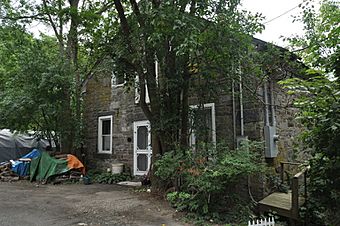Chipman's Point facts for kids
Quick facts for kids |
|
|
Chipman's Point
|
|
 |
|
| Location | Chipman Point Rd., Orwell, Vermont |
|---|---|
| Area | 3 acres (1.2 ha) |
| Built | 1810 |
| NRHP reference No. | 96001519 |
| Added to NRHP | December 26, 1996 |
Chipman's Point is a special historic place in Orwell, Vermont. It was once a busy ferry complex in the 1800s. Here, you can still see two old stone buildings called warehouses. There's also the spot where a ferry used to cross Lake Champlain until 1975. You can also find the old foundations of the Chipman Point Hotel. This important site was added to the National Register of Historic Places in 1996.
Contents
What is Chipman's Point?
Chipman's Point is found on the eastern side of Lake Champlain. It's across the lake from Wright, New York. You can get there by following Chipman Point Road from Vermont Route 73A. The road ends at the old ferry landing. Today, this spot is used for launching boats and fishing.
Exploring the Old Buildings
South of the landing, you'll see two large stone warehouses. These buildings have four stories. They were built right on the lakeshore, on natural rock formations. Higher up, on a small hill, are the remains of the Chipman Point Hotel. These old buildings and hotel ruins are mostly made from local limestone. This stone likely came from nearby quarries.
A Busy Hub in the Past
In the middle of the 1800s, Chipman's Point was a very important place. It was one of the biggest and busiest centers in Orwell. The area had a church, a post office, a hotel, and homes. Everything was focused on the ferry and shipping business.
What Were the Warehouses For?
The stone warehouses were used to store goods. These goods were waiting to be shipped across the lake. Or they were waiting to be picked up for delivery to local towns. The hotel served people who were traveling. Sadly, the hotel burned down in 1952.
Why Did Things Change?
The importance of Lake Champlain for transportation slowly decreased. This happened after the railroad arrived in the area in 1849. Trains became a faster way to move goods and people. Even the ferry service across the lake eventually stopped in 1975.



